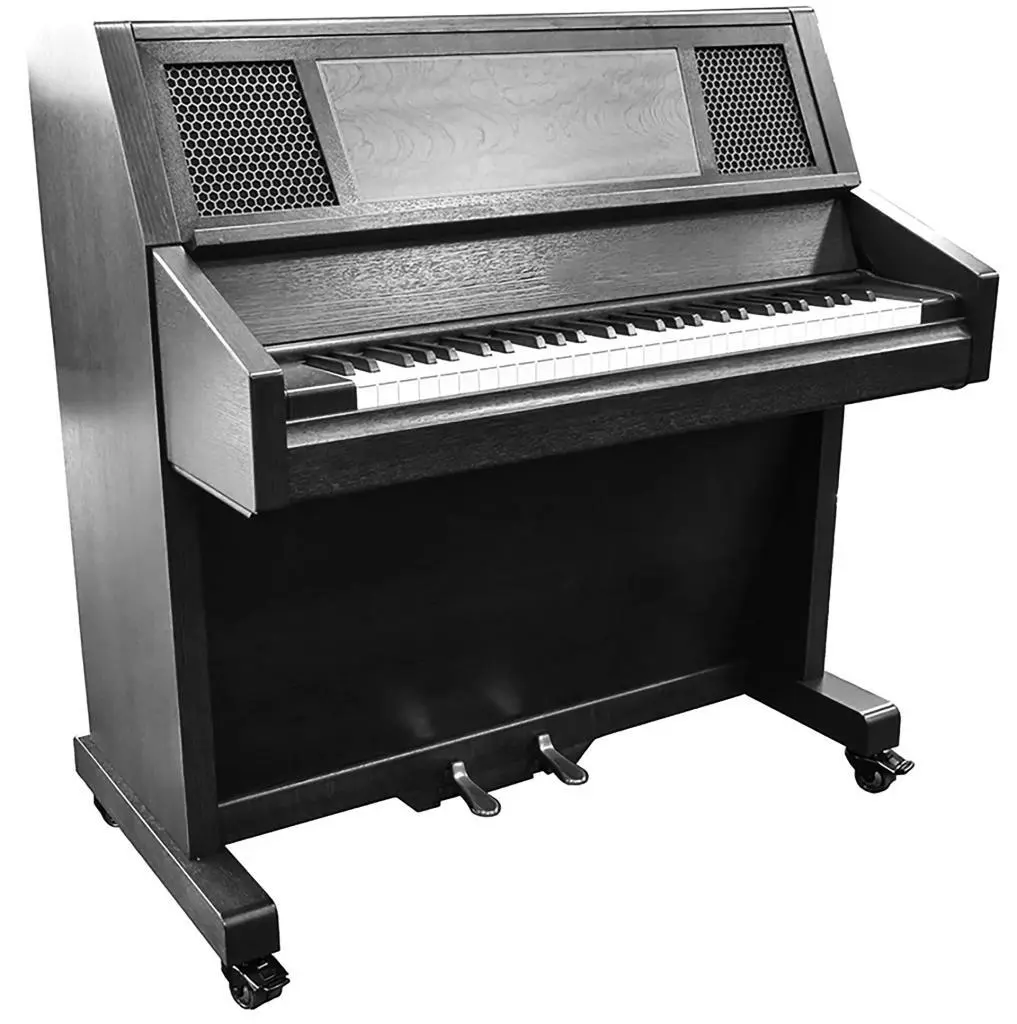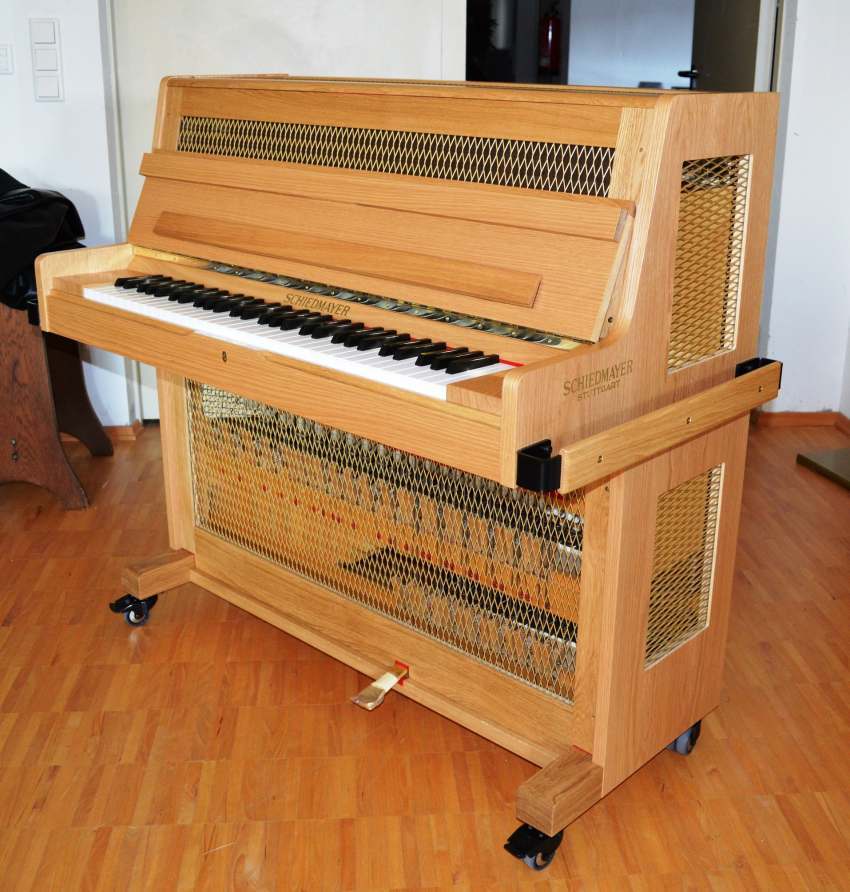Celesta
Keyboard Instruments
Europe
Between 1001 and 1900 AD
Video
The celesta is a keyboard percussion instrument that produces a delicate, bell-like sound. Its appearance resembles that of a small upright piano, with a wooden case, a keyboard, and foot pedals. Unlike a piano, which uses hammers striking strings, the celesta produces sound by hammers striking metal plates or bars that are suspended over wooden resonators. This gives the instrument its signature ethereal and shimmering tone. The celesta is widely recognized for its unique, celestial sound, often used in orchestral and ballet music, film scores, and even jazz.
Celestas come in different sizes and models, generally categorized based on the number of octaves and the mechanism used to amplify sound. The most common types include four-octave and five-octave models, with the latter providing a wider range of musical notes. Some models are built with an enclosed wooden frame to enhance resonance, while others incorporate felt dampers to control the sustain of the notes.
The instrument also shares similarities with the glockenspiel, which is a metallophone played with mallets. However, unlike the glockenspiel, the celesta’s sound is softer due to its felt-covered hammers and wooden resonators. This results in a tone that is more delicate and sustained, making it an essential instrument in orchestral music where a mystical or dreamy effect is desired.
History and Origin
The celesta originates from Europe, specifically in France, during the late 19th century. It was invented by Auguste Mustel, a Parisian instrument maker, in 1886. The celesta was an improvement upon an earlier instrument called the dulcitone, which had a similar mechanism but used tuning forks instead of metal plates. The dulcitone had a pleasant sound but was limited in volume and projection, making it unsuitable for large orchestras or concert performances. Mustel’s innovation introduced metal bars and wooden resonators, significantly enhancing the instrument’s tonal quality and dynamic range.
The instrument quickly gained recognition and was first used in classical music compositions in the late 19th century. One of the earliest and most famous pieces featuring the celesta is Pyotr Ilyich Tchaikovsky’s “Dance of the Sugar Plum Fairy” from The Nutcracker (1892). Tchaikovsky was one of the first composers to use the celesta in a symphonic setting, recognizing its potential for adding a magical and otherworldly character to music.
Although the celesta was developed in France, it soon spread across Europe and America, becoming a standard part of orchestral and film music. By the 20th century, it was widely used in various genres, including jazz, popular music, and contemporary compositions.
Types and Features of the Celesta
The celesta has undergone various modifications since its invention. Modern celestas are categorized based on their size, range, and construction materials. The two main types of celestas are the four-octave and five-octave versions, with some variations in between.
Four-Octave Celesta: This type covers a range from C4 to C8, making it suitable for most orchestral compositions. It is the most commonly used celesta and is ideal for standard musical arrangements.
Five-Octave Celesta: This version extends the range down to F3, providing a richer bass register. It is often preferred by composers who require a broader tonal range and greater harmonic depth.
Key features of the celesta include:
Metal Sound Plates: These plates are tuned to specific pitches and are responsible for the instrument’s distinctive timbre.
Wooden Resonators: Positioned beneath the metal bars, these amplify and enhance the sound, giving it a warm and rounded quality.
Felt-Covered Hammers: The hammers strike the metal plates softly, ensuring a smooth and bell-like tone.
Pedals and Dampers: The sustain pedal allows musicians to control the resonance and duration of each note, similar to the sustain pedal on a piano.
Keyboard Layout: The celesta’s keyboard is identical to that of a piano, making it accessible to pianists and keyboardists alike.
Work Mechanics of the Celesta
The celesta operates on a relatively simple yet effective mechanism. When a key is pressed, it triggers a small felt-covered hammer to strike a corresponding metal plate. The vibration of the plate produces a resonant sound, which is amplified by wooden resonators beneath the plates. This design allows the celesta to generate a clear and sustained tone that can be controlled in terms of dynamics and articulation.
The sustain pedal plays an important role in the celesta’s expressive capabilities. When engaged, it lifts the dampers, allowing notes to resonate freely for a longer duration. When released, the dampers stop the vibration, creating a more staccato effect. This allows musicians to shape phrases with fluidity or precision, depending on the desired musical effect.
Unlike a piano, where hammers strike strings and create a percussive attack, the celesta’s metal plates produce a softer, more rounded tone. This makes it ideal for melodies that require a sense of lightness and magic, as well as for harmonic textures that need to stand out without overpowering the rest of the ensemble.
Role in Music
The celesta is widely used across various musical genres, particularly in classical, film, and jazz music. Its ethereal sound makes it a favorite for composers looking to add a sense of wonder and enchantment to their works.
Classical and Orchestral Music
The celesta is a staple in orchestral music, often employed for its delicate and shimmering sound. Some of the most notable classical pieces featuring the celesta include:
The Nutcracker by Tchaikovsky, particularly in “Dance of the Sugar Plum Fairy.” Scheherazade by Rimsky-Korsakov, where it adds a mystical touch. Peter and the Wolf by Prokofiev, used to represent the bird’s delicate and playful character. Firebird Suite by Stravinsky, where it contributes to the magical atmosphere.
Film and Popular Music
The celesta is widely used in film scores, especially in fantasy and animated films. Some famous soundtracks featuring the celesta include:
1. Harry Potter series, where it is used in “Hedwig’s Theme” to create a sense of mystery and enchantment.
2. E.T. the Extra-Terrestrial by John Williams, where it adds to the film’s whimsical feel.
3. Charlie and the Chocolate Factory, in which the celesta’s dreamlike sound complements the film’s imaginative world.
In popular music, the celesta has been used by artists such as The Beatles in “Baby It’s You” and The Rolling Stones in “She’s a Rainbow.” It has also found a place in jazz, where its unique timbre blends well with brass and woodwind instruments.
Significance of the Celesta
The celesta holds a unique place in the world of musical instruments. Its ability to produce a soft, bell-like sound makes it invaluable for adding texture and atmosphere to compositions. Unlike other keyboard instruments, the celesta’s tone is not overly percussive, allowing it to blend seamlessly into various musical settings.
Its significance lies in its versatility and distinct timbre. The celesta can evoke a range of emotions, from mystery and wonder to nostalgia and tranquility. In orchestral music, it enhances melodies with a light, shimmering quality. In film and theater, it creates a magical ambiance. In jazz and popular music, it adds an unexpected but beautiful texture.
Despite being a niche instrument, the celesta continues to be a vital component of music, maintaining its place in classical repertoires, modern compositions, and cinematic soundscapes. Its invention revolutionized orchestral music by providing composers with an instrument capable of producing a sound that was both delicate and expressive, ensuring its lasting relevance in musical history.
FAQ
What type of instrument is the celesta?
The celesta is a struck idiophone, classified as a percussion instrument despite its keyboard appearance. It is used to produce a soft, bell-like sound.
What are some notable features of the celesta?
The celesta features a soft, bell-like timbre, a transposing pitch sounding one octave higher than written, and often includes a damper pedal for sustained notes.
What materials are commonly used in the construction of the celesta?
The celesta is constructed with metal plates or bars, typically made from steel or a special alloy, and wooden resonators. The hammers are covered with felt.
 Links
Links
References
Other Instrument
Categories



















